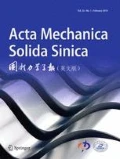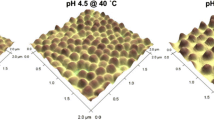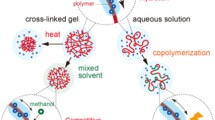Abstract
Poly (N-isopropylacrylamide) (PNIPAM) microgels are widely used in drug delivery due to their fast response to temperature. In order to get a better biocompatibility, PNIPAM microgels are typically coated with a layer of biocompatible material, resulting in composite microgels with core-shell structure. In a composite microgel prepared recently, for example, a microsphere of PNIPAM gel is enclosed by a phospholipid membrane, and the composite microgel exhibits a substantial volume transition in response to temperature changes. Here we develop a theoretical model to describe the thermal-responsive behavior of this composite microgel. In particular, we treat the phospholipid membrane as an elastic layer behaving like rubber-like elastomers and adopt the form of the free-energy function for nematic gels (which refer to anther species of thermal-sensitive gels whose behavior has been intensively studied) as that for PNIPAM gels. We show that the thermal-responsive behavior of the composite microgel can be markedly influenced by the membrane. By investigating the state of stress on the interface, we further predict that when the coating membrane is stiff and thin, wrinkles are expected to occur on the outer surface of the composite microgel after the volume transition.
Similar content being viewed by others
References
Huang, J. and Wu, Y.X., Effects of pH, salt, surfactant and composition on phase transition of poly (NIPAm/MAA) nanoparticles. Journal of Polymer Science: Part A: Polymer Chemistry, 1999, 37(14), 2667–2676.
Park, T.G., Temperature modulated protein release from pH/temperature-sensitive hydrogels. Biomaterials, 1999, 20(6): 517–521.
Ichikawa, H. and Fukumori, Y., A novel positively thermosensitive controlled-release microcapsule with membrane of nano-sized poly (N-isopropylacrylamide) gel dispersed in ethylcellulose matrix. Journal of Controlled Release, 2000, 63(1–2): 107–119.
Chu, L., Park, S., Yamaguchi, T. and Nakao, S., Preparation of thermo-responsive core-shell microcapsules with a porous membrane and poly (N-isopropylacrylamide) gates. Journal of Membrane Science, 2001, 192(1–2): 27–39.
Hoare, T., Santamaria, J., Goya, G.F., Irusta, S., Lin, D., Lau, S., Padera, R., Langer, R. and Kohane, D.S., A magnetically triggered composite membrane for on-demand drug delivery. Nano Letters, 2009, 9(10): 3651–3657.
Kono, K., Henmi, A., Yamashita, H., Hayashi, H. and Takagishi, T., Improvement of temperature-sensitivity of poly (N-isopropylacrylamide)—modified liposomes. Journal of Controlled Release, 1999, 59(1): 63–75.
Lin, C.L., Chiu, W.Y. and Lee, C.F., Thermal/pH-sensitive core-shell copolymer latex and its potential for targeting drug carrier application. Polymer, 2005, 46: 10092–10101.
Yu, Y., Xie, R., Zhang, M., Li, P., Yang, L., Ju, X. and Chu, L., Monodisperse microspheres with poly (N-isopropylacrylamide) core and poly (2-hydroxyethyl methacrylate) shell. Journal of Colloid and Interface Science, 2010, 346(2): 361–369.
Faivre, M., Campillo, C., Pepin-Donat, B. and Viallat, A., Responsive giant vesicles filled with poly (N-isopropylacrylamide) sols or gels. Progress in Colloid and Polymer Science, 2006, 133: 41–44.
Campillo, C.C., Pepin-Donat, B. and Viallat, A., Responsive viscoelastic giant lipid vesicles filled with a poly (N-isopropylacrylamide) artificial cytoskeleton. Soft Matter, 2007, 3(11): 1421–1427.
Campillo, C.C., Schroder, A.P., Marques, C.M. and Pepin-Donat, B., Volume transition in composite poly (NIPAM)-giant unilamellar vesicles. Soft Matter, 2008, 4(12): 2486–2491.
Campillo, C.C., Schroder, A.P., Marques, C.M. and Pepin-Donat, B., Composite gel-filled giant vesicles: Membrane homogeneity and mechanical properties. Materials Science and Engineering: C, 2009, 29(2): 393–397.
Flory, P.J. and Rehner, J.J., Statistical mechanics of cross-linked polymer networks I: rubberlike elasticity. Journal of Chemical Physics, 1943, 11(11): 512–520.
Hong, W., Zhao, X., Zhou, J. and Suo, Z., A theory of coupled diffusion and large deformation in polymeric gels. Journal of the Mechanics and Physics of Solids, 2008, 56(5): 1779–1793.
Suo, Z., Theory of dielectric elastomers. Acta Mechanica Solida Sinica, 2010, 23(6): 549–578.
Warner, M. and Wang, X.J., Phase equilibria of swollen nematic elastomers. Macromolecules, 1992, 25(1): 445–449.
Fried, E. and Sellers, S., Free-energy density functions for nematic elastomers. Journal of the Mechanics and Physics of Solids, 2004, 52(7): 1671–1689.
Sawa, Y., Urayama, K., Takigawa, T., Desimone, A. and Teresi, L., Thermally driven giant bending of liquid crystal elastomer films with hybrid alignment. Macromolecules, 2010, 43(9): 4362–4369.
Desimone, A. and Teresi, L., Elastic energies for nematic elastomers. The European Physical Journal E: Soft Matter and Biological Physics, 2009, 29(2): 191–204.
Hirokawa, Y. and Tanaka, T., Volume phase transition in a nonionic gel. Journal of Chemical Physics, 1984, 81(12): 6379–6380.
Huang, Z.Y., Hong, W. and Suo, Z., Nonlinear analyses of wrinkles in a film bonded to a compliant substrate. Journal of the Mechanics and Physics of Solids, 2005, 53(9): 2101–2118.
Mei, H., Huang, R., Chung, J.Y., Stafford, C.M. and Yu, H., Buckling modes of elastic thin films on elastic substrates. Applied Physics Letters, 2007, 90(5): 151902–151903.
Author information
Authors and Affiliations
Corresponding author
Additional information
Project supported by the National Natural Science Foundation of China (No. 11090334) and Shanghai Leading Academic Discipline Project (No. B302).
Rights and permissions
About this article
Cite this article
Wu, Z., Zhong, Z. A Theoretical Model for Thermal-Sensitive Microgel with PNIPAM Core and Elastic Shell. Acta Mech. Solida Sin. 25, 520–529 (2012). https://doi.org/10.1016/S0894-9166(12)60046-9
Received:
Published:
Issue Date:
DOI: https://doi.org/10.1016/S0894-9166(12)60046-9




